Quad Software | Technology that makes it simple
WebGL
Un article de Wikipédia, l'encyclopédie libre. Fonctionnement[modifier | modifier le code] WebGL permet d'afficher, de créer et de gérer dynamiquement des éléments graphiques complexes en 3D dans la fenêtre du navigateur web d'un client. Lorsqu’un élément graphique de type WebGL est inclus dans une page web, le navigateur exécute un programme en JavaScript utilisant l'interface WebGL. Implémentations[modifier | modifier le code] Si, en septembre 2009, aucun navigateur web ne permettait l'affichage 3D directement dans le navigateur sans greffon, ça n'est plus le cas aujourd'hui[3]: Limitations[modifier | modifier le code] WebGL est basé sur OpenGL ES 2.0 (OpenGL for Embedded Systems), une version d'OpenGL destinée aux systèmes embarqués. Comme WebGL est basé sur OpenGL ES, certaines fonctionnalités d'OpenGL y sont absentes, dont : Khronos Group prépare depuis 2012 le brouillon de la norme WebGL 2.0, basée sur OpenGL ES 3.0[9],[10],[11]. Problèmes de jeunesse[modifier | modifier le code]
Interactive 3D Graphics Course With Three.js & WebGL
When does the course begin? This class is self paced. You can begin whenever you like and then follow your own pace. How long will the course be available? This class will always be available! How do I know if this course is for me? Take a look at the “Class Summary,” “What Should I Know,” and “What Will I Learn” sections above. Can I skip individual videos? Yes! How much does this cost? It’s completely free! What are the rules on collaboration? Collaboration is a great way to learn. Why are there so many questions? Udacity classes are a little different from traditional courses. What should I do while I’m watching the videos? Learn actively!
CityEngine | 3D Modeling Software for Urban Environments
Menu Products Esri CityEngine Transform 2D GIS data into smart 3D city models. 30-Day Free Trial → Main Features Getting Started Industries Pricing Try It Free Design a Smarter City Esri CityEngine improves urban planning, architecture, and design. Watch the Video: Build Smart 3D Cities “Turning Zoning laws with CityEngine into vivid three dimensional visualizations, is drastically changing the way we understand and plan our sustainable future environments.” Niels Lehmann, Urban Synergy Group Build Flexible Scenarios Faster Compare and analyze building proposals from every angle. Create Realistic Context See where a proposed building blocks the view, casts shadows, and reflects heat. Share Your Urban Plan Publish your 3D model online. Sign up for a free trial. Esri Home » Products Follow Us Contact Us | Privacy | Legal | Site Map
How Far is the Reach of WebGL on the Desktop - Renaun Erickson | Renaun Erickson
WebGL WebGL is definitely making some great in-roads into desktop browsers. There are a lot of other HTML5 features that round out WebGL for games, for example check out some AAA web demos here. In talking to people there seems to be some confusion about what is the real reach vs all the hype. Of course WebGL keeps changing fast, one of the reasons for all the hype, but I wanted to talk about the current technical landscape of WebGL. Background WebGL is not a W3C specification, it is driven by the Khronos Group. WebGL is a cross-platform, royalty-free web standard for a low-level 3D graphics API based on OpenGL ES 2.0, exposed through the HTML5 Canvas element as Document Object Model interfaces. If you have noticed there is one major browser vendor missing from the list, Microsoft (Internet Explorer). Ok, so in the real world what browsers have WebGL? Don’t forget GPUs Even if all the browser vendors supported WebGL fully out of the box there are other factors that affect reach.
Interactive 3D graphics for the Web, at last
Up until now, it is claimed, interactive 3D graphics have not been available on the World Wide Web, even though "almost all PCs as well as mobile and embedded devices already contain high-performance 3D graphics hardware to process it." Two development groups have teamed up to change that. In a joint press release published at Phys.Org, the German Research Center for Artificial Intelligence and Fraunhofer Institute for Computer Graphics Research report they "are working to describe computer scenes in spatial detail directly within the websites’ code." The two teams report they have agreed on a common proposal to extend the Hypertext Markup Language (HTML) to include advanced graphics capabilities. The two institutes originally each had their own proposals, namely X3DOM and XML3D, but say they are now distilling their technologies into common components to bring interactive and highly dynamic 3D graphics to the declarative world of HTML. (Photo by Joe McKendrick.
Procedural generation
Procedural generation is a widely used term in the production of media; it refers to content generated algorithmically rather than manually. Often, this means creating content on the fly rather than prior to distribution. This is often related to computer graphics applications and video game level design. Overview[edit] The term procedural refers to the process that computes a particular function. Fractals, an example of procedural generation,[1] dramatically express this concept, around which a whole body of mathematics—fractal geometry—has evolved. The modern demoscene uses procedural generation to package a great deal of audiovisual content into relatively small programs. In recent years, there has been an increasing interest in procedural content generation within the academic game research community, especially among researchers interested in applying artificial intelligence methods to the problems of PCG. Contemporary application[edit] Video games[edit] Film[edit] Middleware[edit]
webglcookbook



